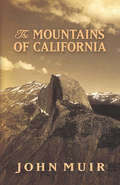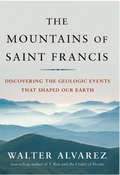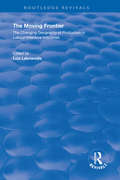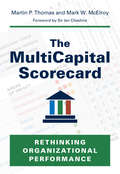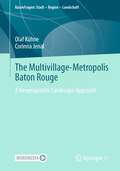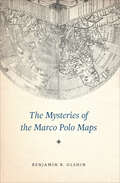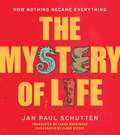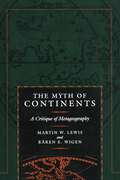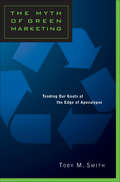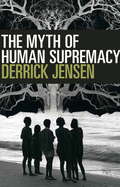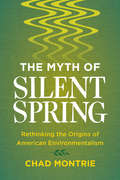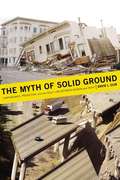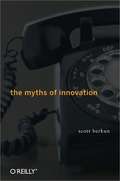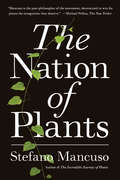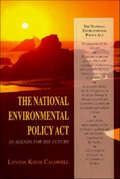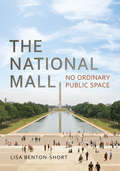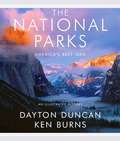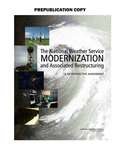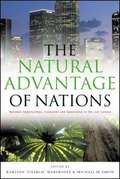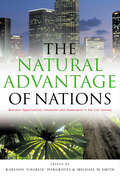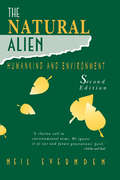- Table View
- List View
The Mountains of California (Large Print Ser.)
by John MuirA great hero of America's conservation movement, John Muir (1838–1914) was active in establishing the Yosemite Valley as a protected national park and in awakening interest in the importance of safeguarding natural resources. In this tribute to the grandeur of the Sierras, Muir recounts his journeys by foot through the Yosemite Valley, Mount Whitney, the famed sequoia forests, King's Canyon, and other wilderness areas. With a natural historian's keen eye for flora, geography, and geology, Muir describes glaciers, lakes, trees, and the daily lives of the region's inhabitants. His lyrical narrative, imbued with the deepest understanding and respect for nature, examines the ways in which natural forces shape the landscape and the effects of the changing seasons. The zesty travelogue is accompanied by splendid illustrations of maps, plants, and animals. Originally published in 1894, The Mountains of California continues to delight and inform readers.
The Mountains of Saint Francis: Discovering the Geologic Events That Shaped Our Earth
by Walter AlvarezThe major new work by the best-selling author of T. Rex and the Crater of Doom--a fascinating history. Walter Alvarez and his team made one of the most astonishing scientific discoveries of the twentieth century--that an asteroid smashed into the Earth 65 million years ago, exterminating the dinosaurs. Alvarez had the first glimmer of that amazing insight when he noticed something odd in a rock outcrop in central Italy. Alvarez now returns to that rich terrain, this time to take the reader on an distant past. We encounter the volcanoes that formed the Seven Hills of Rome; the majestic limestone Apennine mountains that started to develop millions of years ago under water; the evidence that the Mediterranean Sea completely evaporated to a sunken desert, perhaps several times; and the proof that continental plates once overran one another to form telling, all major geologic episodes are as dramatic as the great impact that killed the dinosaurs, even when they happen over eons and without huge creatures to witness them.
The Moving Frontier: The Changing Geography of Production in Labour-Intensive Industries (Routledge Revivals)
by Lois LabrianidisOriginally published in 1992 and based on two theoretical approaches: the Global Commodity Chain and the Global Production Network, this book investigates the multitude of processes, as well as diverse consequences of global integration upon industries, regions, enterprises and employees. In doing so, it draws from the experience of Western and Eastern and South-eastern Europe. These European cases are complemented with evidence from Kenya, Thailand as well as US, China, India and Mexico. The book explores multiple causes of decentralization, arguing beyond the pursuit of cheap and adaptable labour. It goes on to argue that the effects of delocalization within Europe, unlike those in the rest of the developed world, are less negative than usually portrayed. It concludes by putting forward recommendations for best future practice of successful adjustment strategies and examines how these might be adopted elsewhere in the world.
The MultiCapital Scorecard: Rethinking Organizational Performance
by Mark W. Mcelroy Martin P. ThomasFor decades now, organizations have been struggling to find the best way to address their social and environmental responsibilities alongside their economic obligations. In other words, they want to know how best to effectively manage their operations based on a triple bottom line (3BL)--one that reflects social, environmental, and economic performance. Recently, an international standard for integrated reporting has emerged that in principle emphasizes the importance of managing toward a triple bottom line. But it fails to provide specific guidance on how to do so. Organizations have been left to their own devices to respond. How should 3BL management actually be done? In this book, sustainability and performance experts Martin Thomas and Mark McElroy introduce the world's most advanced 3BL performance accounting methodology: The MultiCapital Scorecard. It is the first context-based integrated measurement, management, and reporting system. And, it can help corporations, public institutions, and other organizations answer the question they should be asking themselves for every aspect of their operations: "How much is enough for us to be sustainable?" The answers set internal performance standards against which operations and their impacts can be measured. Nothing less will do! The MultiCapital Scorecard describes this open-source methodology, which consists of a structured, quantitative measurement and reporting system that complies with international standards for 3BL integrated measurement and reporting. Moreover, the MultiCapital Scorecard is designed to help organizations assess their own 3BL performance in their own contexts with context-based metrics of their own choosing. An eminently practical management aid for integrated thinking, it can be tailored to any organization's needs. The authors also describe how and why businesses are gradually shifting from managing impacts on only one type of capital (economic) to managing impacts on multiple types. They also provide detailed examples of worked reports, showing how organizations might develop and quantify the interim and long-term goals to meet their obligations to their employees, community, shareholders, and the environment. The examples also show how an organization can use the Multicapital Scorecard methodology to assess their progress in meeting those goals, and convey that progress to their stakeholders.
The Multivillage-Metropolis Baton Rouge: A Neopragmatic Landscape Approach (RaumFragen: Stadt – Region – Landschaft)
by Olaf Kühne Corinna JenalThe capital of Louisiana, Baton Rouge, has been the scene of fundamental changes in recent decades. In the context of the tripole of petrochemistry, Louisiana State University (LSU) and public administration (especially of the state of Louisiana), which has been fully developed since the end of the 1920s, general processes (such as the transition from modern to post-modern spatial development) mix with specific local and regional characteristics and logics, also in dealing with spaces (such as the eccentric location of the downtown area, the limited influence of spatial planning). The result is a social-spatial formation of a 'multivillage metropolis'. The investigation of this 'multivillage metropolis' follows a neopragmatic approach that triangulates different theories, methods, data and researcher perspectives.Videos per App: Laden Sie die Springer Nature More Media kostenlos herunter - Abbildungen im Buch per App mit Handy oder Tablet scannen, um Videos zu streamen.
The Mysteries of the Marco Polo Maps
by Benjamin B. OlshinWhat&’s the truth behind the travels of Marco Polo? &“A fascinating tale about maps, history and exploration.&”—Times Literary Supplement (UK) In the thirteenth century, Italian merchant and explorer Marco Polo traveled from Venice to the far reaches of Asia, a journey he chronicled in a narrative titled Il Milione, later known as The Travels of Marco Polo. While Polo&’s writings would go on to inspire the likes of Christopher Columbus, scholars have long debated their veracity. Some have argued that Polo never even reached China—while others believe that he came as far as the Americas. Now, there&’s new evidence for this historical puzzle: a very curious collection of fourteen little-known maps and related documents said to have belonged to the family of Marco Polo himself. Here, historian of cartography Benjamin B. Olshin offers the first credible book-length analysis of these artifacts, charting their course from obscure origins in the private collection of Italian-American immigrant Marcian Rossi in the 1930s; to investigations of their authenticity by the Library of Congress, J. Edgar Hoover, and the FBI; to the work of the late cartographic scholar Leo Bagrow; to Olshin&’s own efforts to track down and study the Rossi maps, all but one of which are in the possession of Rossi&’s great-grandson. Are the maps forgeries, facsimiles, or modernized copies? Did Marco Polo&’s daughters—whose names appear on several of the artifacts—preserve in them geographic information about Asia first recorded by their father? Or did they inherit maps created by him? Did Marco Polo entrust the maps to an admiral with links to Rossi&’s family line? Or, if the maps have no connection to Marco Polo, who made them, when, and why? Regardless of the maps&’ provenance, this tale takes us on a fascinating journey, offering insights into Italian history, the age of exploration, and the wonders of cartography. &“Olshin&’s book tugs powerfully at the imagination of anybody interested in the Polo story, medieval history, old maps, geographical ideas, European voyages of discovery, and early Chinese legends.&”—The Wall Street Journal
The Mystery of Life
by Jan Paul Schutten Floor RiederHow did nonliving atoms evolve into modern people? Find out in this engaging illustrated exploration of how nothing became everything.The science of evolution is a topic of utmost importance, especially as the focus on STEM (Science, Technology, Engineering, Math) education continues to increase. Fortunately, important doesn't have to mean boring. From explaining how scientists discovered how life began on earth to speculating about whether space aliens are carnivores, this engaging investigation of all things evolution is infused with fun as well as facts. Coupled with gorgeous illustrations, curious minds yound and old will discover how to build a planet, the truth about DNA, whether trees really want to be tall, how to survive without a butt, and much, much more!
The Myth of Continents: A Critique of Metageography
by Kären E. Wigen Martin W. LewisIn this thoughtful and engaging critique, geographer Martin W. Lewis and historian Kären Wigen reexamine the basic geographical divisions we take for granted, and challenge the unconscious spatial frameworks that govern the way we perceive the world. Arguing that notions of East vs. West, First World vs. Third World, and even the sevenfold continental system are simplistic and misconceived, the authors trace the history of such misconceptions. Their up-to-the-minute study reflects both on the global scale and its relation to the specific continents of Europe, Asia, and Africa--actually part of one contiguous landmass. The Myth of Continents sheds new light on how our metageographical assumptions grew out of cultural concepts: how the first continental divisions developed from classical times; how the Urals became the division between the so-called continents of Europe and Asia; how countries like Pakistan and Afghanistan recently shifted macroregions in the general consciousness. This extremely readable and thought-provoking analysis also explores the ways that new economic regions, the end of the cold war, and the proliferation of communication technologies change our understanding of the world. It stimulates thinking about the role of large-scale spatial constructs as driving forces behind particular worldviews and encourages everyone to take a more thoughtful, geographically informed approach to the task of describing and interpreting the human diversity of the planet.
The Myth of Green Marketing
by Toby SmithIn this groundbreaking study, Toby Smith analyses the role that social myths such as green marketing play in public understanding of the environmental crisis. This book introduces the concept of hegemony into environmental politics, using the concept to elucidate the political, economic, and social alliance that sustains our belief in industrial expansionism. The ecological crisis of the late twentieth century presents a challenge to the very foundations of this alliance. The hegemonic system reacts to a threat to its structure by producing social myths that provide a common sense understanding of the threat. Smith examines one such social myth, the contemporary phenomenon known as green marketing, and how it came to reinforce, rather than challenge, the ethics of productivism. By analysing green marketing as it relates primarily to the early 1990s corporate campaigns of companies such as McDonald's, Shell Chemicals, and Mobil Chemical Co., Smith demonstrates how these voices weave together an understanding of green consumerism using familiar language from economic and liberal democratic discourses. The Myth of Green Marketing is an original and important contribution to the field of environmental studies. As the first book on green marketing, it is sure to raise controversy with its unique discussion of the cultural and social aspects of environmental issues.
The Myth of Human Supremacy
by Derrick JensenIn this impassioned polemic, radical environmental philosopher Derrick Jensen debunks the near-universal belief in a hierarchy of nature and the superiority of humans. Vast and underappreciated complexities of nonhuman life are explored in detail--from the cultures of pigs and prairie dogs, to the creative use of tools by elephants and fish, to the acumen of caterpillars and fungi. The paralysis of the scientific establishment on moral and ethical issues is confronted and a radical new framework for assessing the intelligence and sentience of nonhuman life is put forth. Jensen attacks mainstream environmental journalism, which too often limits discussions to how ecological changes affect humans or the economy--with little or no regard for nonhuman life. With his signature compassionate logic, he argues that when we separate ourselves from the rest of nature, we in fact orient ourselves against nature, taking an unjust and, in the long run, impossible position.Jensen expresses profound disdain for the human industrial complex and its ecological excesses, contending that it is based on the systematic exploitation of the earth. Page by page, Jensen, who has been called the philosopher-poet of the environmental movement, demonstrates his deep appreciation of the natural world in all its intimacy, and sounds an urgent call for its liberation from human domination.From the Trade Paperback edition.
The Myth of Silent Spring: Rethinking the Origins of American Environmentalism
by Chad MontrieSince its publication in 1962, Rachel Carson’s book Silent Spring has often been celebrated as the catalyst that sparked an American environmental movement. Yet environmental consciousness and environmental protest in some regions of the United States date back to the nineteenth century, with the advent of industrial manufacturing and the consequent growth of cities. As these changes transformed people's lives, ordinary Americans came to recognize the connections between economic exploitation, social inequality, and environmental problems. As the modern age dawned, they turned to labor unions, sportsmen’s clubs, racial and ethnic organizations, and community groups to respond to such threats accordingly. The Myth of Silent Spring tells this story. By challenging the canonical “songbirds and suburbs” interpretation associated with Carson and her work, the book gives readers a more accurate sense of the past and better prepares them for thinking and acting in the present.
The Myth of Solid Ground: Earthquakes, Prediction, and the Fault Line Between Reason and Faith
by David L. UlinUlin shares his fascination with earthquakes, their science and how we think about them. A fascinating book; a conversational consideration of quakes and those who live through them.
The Myths of Innovation
by Scott BerkunHow do we know if a hot new technology will succeed or fail? Most of us, even experts, get it wrong all the time. We depend more than we realize on wishful thinking and romanticized ideas of history. In the new paperback edition of this fascinating book, a book that has appeared on MSNBC, CNBC, Slashdot.org, Lifehacker.com and in The New York Times, bestselling author Scott Berkun pulls the best lessons from the history of innovation, including the recent software and web age, to reveal powerful and suprising truths about how ideas become successful innovations -- truths people can easily apply to the challenges of today. Through his entertaining and insightful explanations of the inherent patterns in how Einstein’s discovered E=mc2 or Tim Berner Lee’s developed the idea of the world wide web, you will see how to develop existing knowledge into new innovations.Each entertaining chapter centers on breaking apart a powerful myth, popular in the business world despite it's lack of substance. Through Berkun's extensive research into the truth about innovations in technology, business and science, you’ll learn lessons from the expensive failures and dramatic successes of innovations past, and understand how innovators achieved what they did -- and what you need to do to be an innovator yourself. You'll discover:Why problems are more important than solutionsHow the good innovation is the enemy of the greatWhy children are more creative than your co-workersWhy epiphanies and breakthroughs always take timeHow all stories of innovations are distorted by the history effectHow to overcome people’s resistance to new ideasWhy the best idea doesn’t often winThe paperback edition includes four new chapters, focused on appling the lessons from the original book, and helping you develop your skills in creative thinking, pitching ideas, and staying motivated."For centuries before Google, MIT, and IDEO, modern hotbeds of innovation, we struggled to explain any kind of creation, from the universe itself to the multitudes of ideas around us. While we can make atomic bombs, and dry-clean silk ties, we still don’t have satisfying answers for simple questions like: Where do songs come from? Are there an infinite variety of possible kinds of cheese? How did Shakespeare and Stephen King invent so much, while we’re satisfied watching sitcom reruns? Our popular answers have been unconvincing, enabling misleading, fantasy-laden myths to grow strong."-- Scott Berkun, from the text"Berkun sets us free to change the world."-- Guy Kawasaki, author of Art of the StartScott was a manager at Microsoft from 1994-2003, on projects including v1-5 (not 6) of Internet Explorer. He is the author of three bestselling books, Making Things Happen, The Myths of Innovation and Confessions of a Public Speaker. He works full time as a writer and speaker, and his work has appeared in The New York Times, Forbes magazine, The Economist, The Washington Post, Wired magazine, National Public Radio and other media. He regularly contributes to Harvard Business Review and Bloomberg Businessweek, has taught creative thinking at the University of Washington, and has appeared as an innovation and management expert on MSNBC and on CNBC. He writes frequently on innovation and creative thinking at his blog: scottberkun.com and tweets at @berkun.
The Nation of Plants
by Stefano MancusoIn this playful yet informative manifesto, a leading plant neurobiologist presents the eight fundamental pillars on which the life of plants—and by extension, humans—rests.Even if they behave as though they were, humans are not the masters of the Earth, but only one of its most irksome residents. From the moment of their arrival, about three hundred thousand years ago—nothing when compared to the history of life on our planet—humans have succeeded in changing the conditions of the planet so drastically as to make it a dangerous place for their own survival. The causes of this reckless behavior are in part inherent in their predatory nature, but they also depend on our total incomprehension of the rules that govern a community of living beings. We behave like children who wreak havoc, unaware of the significance of the things they are playing with. In The Nation of Plants, the most important, widespread, and powerful nation on Earth finally gets to speak. Like attentive parents, plants, after making it possible for us to live, have come to our aid once again, giving us their rules: the first Universal Declaration of Rights of Living Beings written by the plants. A short charter based on the general principles that regulate the common life of plants, it establishes norms applicable to all living beings. Compared to our constitutions, which place humans at the center of the entire juridical reality, in conformity with an anthropocentricism that reduces to things all that is not human, plants offer us a revolution.
The National Environmental Policy Act: An Agenda for the Future
by Lynton Keith Caldwell"The National Environmental Policy Act has grown more, not less, important in the decades since its enactment. No one knows more about NEPA than Lynton Caldwell. And no one has a clearer vision of its relevance to our future. Highly recommended." —David W. Orr, Oberlin CollegeWhat has been achieved since the National Environmental Policy Act was passed in 1969? This book points out where and how NEPA has affected national environmental policy and where and why its intent has been frustrated. The roles of Congress, the President, and the courts in the implementation of NEPA are analyzed. Professor Caldwell also looks at the conflicted state of public opinion regarding the environment and conjectures as to what must be done in order to develop a coherent and sustained policy.
The National Mall: No Ordinary Public Space
by Lisa Benton-ShortThe National Mall in Washington, D.C. is one of the most important and highly visible urban public spaces in the U.S. It is considered by many Americans to be "the nation's front yard." Yet few have written about the role of this public space in the twenty-first century. In The National Mall, Lisa Benton-Short explores the critical issues that are redefining and reshaping this extraordinary public space. Her work focuses on three contemporary and interrelated debates about public space: the management challenges faced by federal authorities, increased demands for access and security post 9/11, and the role of the public in the Mall's long-term planning and development plans. By taking a holistic view of the National Mall and analyzing the unique twenty-first century challenges it faces, Lisa Benton-Short provides a fluid, cohesive, and timely narrative that is as extraordinary as the Mall itself.
The National Parks: An Illustrated History
by Ken Burns Dayton DuncanThe companion volume to the new Ken Burns film: a magnificently illustrated history of the American National Park System. In a rich, deeply informative narrative, Dayton Duncan and Ken Burns examine how each new park was brought into the system.
The National Weather Service Modernization and Associated Restructuring
by Committee on the Assessment of the National Weather Service's Modernization ProgramThe Modernization and Associated Restructuring (MAR) of the National Weather Service (NWS) was a large and complex re-engineering of a federal agency. The process lasted a decade and cost an estimated $4.5 billion. The result was greater integration of science into weather service activities and improved outreach and coordination with users of weather information. The MAR created a new, modernized NWS, and, significantly, it created a framework that will allow the NWS to keep up with technological changes in a more evolutionary manner. The MAR was both necessary and generally well executed. However, it required revolutionary, often difficult, changes. The procurement of large, complex technical systems presented challenges in and of itself. The MAR also affected the career paths and personal lives of a large portion of the field office workforce. The MAR created a new, modernized NWS, and, significantly, it created a framework that will allow the NWS to keep up with technological changes in a more evolutionary manner. The National Weather Service Modernization and Associated Restructuring presents the first comprehensive assessment of the execution of the MAR and its impact on the provision of weather services in the United States. This report provides an assessment that addresses the past modernization as well as lessons learned to support future improvements to NWS capabilities.
The Natural Advantage of Nations: Business Opportunities, Innovation and Governance in the 21st Century
by Charlie Hargroves Michael H. SmithThe days of trade-offs between the environment, society, and business are over, proclaim professionals and researchers with The Natural Edge Project. They walk particularly business leaders but also other readers through the various dimensions of sustainability and the actors and forces at work in each. The themes are the need for a new paradigm, natural advantage as a business imperative, achieving a natural advantage of nations, sustainable cities, and a national collaborative approach.
The Natural Advantage of Nations: Business Opportunities, Innovations and Governance in the 21st Century
by Michael H. Smith KarlsonThis book is more than just a 'palliative care' guide for the planet - it is about innovation, solutions, competitiveness and profitability. At work, at home and as members of society, our generation has an opportunity - to be part of the obligation - and an exciting solution in restoring the balance. The authors present a bold vision for the future and demonstrate how we can get there, drawing on lessons of competitive advantage theory and the latest in sustainability, economics, innovation, business and governance theory and practice. The result is nothing less than the most authoritative and comprehensive guide to date, to building the new ecologically sustainable economy. For further information about The Natural Edge Project and to view the book's online companion, visit www.naturaledgeproject.net.
The Natural Alien
by Neil EverndenIn this eloquent and sympathetic book, Evernden evaluates the international environmental movement and the underlying assumptions that could doom it to failure. Beginning with a simple definition of environmentalists as "those who confess a concern for the non-human," he reviews what is inherent in industrial societies to make them so resistant to the concerns of environmentalists. His analysis draws on citing such diverse sources as Merleau-Ponty, Heidegger, and TIME, and examines how we tend to think about the world and how we might think about it.The book does not offer solutions to environmental questions, but it does offer the hope that there can be new ways of thinking and flexibility in human/environmental relations. Although humans seem alienated from our the natural world, we can develop a new understanding of `self in the world.'The second edition has a new preface and an epilogue in which Evernden analyses the latest environmental catch-phrase: sustainable development.
The Natural Alien: Humankind and Environment
by Neil EverndenAn aura of success seems to surround the environmental movement today. Its concerns are voiced by news media and heeded by governments around the world. But its real achievements have been few, and the publicity they have generated may disguise the movement's essential futility. In this thoughtful and sympathetic evaluation of the international environmental movement Evernden raises grave doubts about its ability even to express adequately its real message, let alone to establish societal acceptance and government support for it. He reviews the assumptions inherent in western industrial societies that make them so resistant to the basic motivating concerns of those active in the environmental cause. From that analysis Evernden considers an alternative view of human/ environmental relations as presented by such thinkers as Merleau-Ponty and Heidegger. Their evocation of self as 'being in the world' is quite different from the dominant 'Cartesian' view, and far more accommodating to the environmentalist's sensibility. Evernden argues that the existence of such differing approaches to human/environment relations is evidence of a flexibility that is a basic feature of humanity. In this flexibility lies the basis of hope. Our uncertainty, although predisposing us to confusion and alienation, also enables us to develop a new understanding of 'self in world.' Only through such understanding can the impulse to environmental advocacy be understood.
The Natural City
by Ingrid Leman Stefanovic Stephen Bede ScharperUrban and natural environments are often viewed as entirely separate entities - human settlements as the domain of architects and planners, and natural areas as untouched wilderness. This dichotomy continues to drive decision-making in subtle ways, but with the mounting pressures of global climate change and declining biodiversity, it is no longer viable. New technologies are promising to provide renewable energy sources and greener designs, but real change will require a deeper shift in values, attitudes, and perceptions. A timely and important collection, The Natural City explores how to integrate the natural environment into healthy urban centres from philosophical, religious, socio-political, and planning perspectives. Recognizing the need to better link the humanities with public policy, The Natural City offers unique insights for the development of an alternative vision of urban life.
The Natural Contract (Studies in Literature and Science)
by Michel Serres Elizabeth MacArthur William PaulsonGlobal environmental change, argues Michel Serres, has forced us to reconsider our relationship to nature. In this translation of his influential 1990 book Le Contrat Naturel, Serres calls for a natural contract to be negotiated between Earth and its inhabitants. World history is often referred to as the story of human conflict. Those struggles that are seen as our history must now include the uncontrolled violence that humanity perpetrates upon the earth, and the uncontrollable menace to human life posed by the earth in reaction to this violence. Just as a social contract once brought order to human relations, Serres believes that we must now sign a "natural contract" with the earth to bring balance and reciprocity to our relations with the planet that gives us life. Our survival depends on the extent to which humans join together and act globally, on an earth now conceived as an entity. Tracing the ancient beginnings of modernity, Serres examines the origins and possibilities of a natural contract through an extended meditation on the contractual foundations of law and science. By invoking a nonhuman, physical world, Serres asserts, science frees us from the oppressive confines of a purely social existence, but threatens to become a totalitarian order in its own right. The new legislator of the natural contract must bring science and law into balance. Serres ends his meditation by retelling the story of the natural contract as a series of parables. He sees humanity as a spacecraft that with the help of science and technology has cast off from familiar moorings. In place of the ties that modernity and analytic reason have severed, we find a network of relations both stranger and stronger than any we once knew, binding us to one another and to the world. The philosopher's harrowing and joyous task, Serres tells us, is that of comprehending and experiencing the bonds of violence and love that unite us in our spacewalk to the spaceship Mother Earth.
The Natural Disaster Survival Handbook: 151 Survival Tactics & Tips (Outdoor Life)
by The Editors of Outdoor LifeHow to survive everything from hurricanes and wildfires to earthquakes and tsunamis, from the editors of Outdoor Life. From basic precautions like knowing how to use a fire extinguisher to emergencies like riding out an avalanche, this comprehensive collection of practical advice prepares you to protect yourself, your home, and your family in a wide variety of situations. Included are sections on: The Essential: Get ready with the right emergency kit and first aid supplies. Be ready for earthquakes, floods, blizzards, and other natural disasters wherever you may be. Learn simple tips and techniques for treating common injuries, assessing danger, and getting to safety fast. The Extreme: When a tornado is bearing down on your car, the floodwaters have cut off your home, or you&’re camping and the lightning strikes seem to be getting closer—what do you do? This book tells you, in simple steps with handy illustrations. The Emergency: Mudslides, avalanche, falling boulders often start without warning, leaving little time to prepare—or even think. Be prepared for the worst so you can react quickly. From the premier publication that was founded nearly 125 years ago, this is a valuable resource for those who want to be ready for anything nature throws at them.
